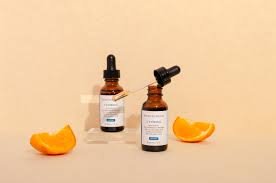
Can I Still Use Oxidised Vitamin C?
Vitamin C is a beloved skincare ingredient with a well-earned reputation as a potent antioxidant that brightens skin, fades dark spots, and protects against environmental damage.
However, despite its popularity, one major downside is its instability.
Vitamin C serums, especially those containing L-Ascorbic Acid—the purest and most effective form—can oxidise quickly, losing their potency and sometimes even causing irritation.
If you’re a skincare enthusiast, you’ve probably encountered a vitamin C serum that has changed color—from clear or pale yellow to a deeper yellow, orange, or brown.
This color change indicates oxidation, which raises the question: Can you still use oxidised vitamin C?
In this article, we’ll unpack the science behind vitamin C oxidation, what it means for your skincare, and practical tips to keep your vitamin C products fresher for longer.
What Is Vitamin C Oxidation?
Vitamin C, chemically known as L-Ascorbic Acid, is highly reactive when exposed to light, air, and heat. This means it can easily degrade—or oxidise—when not stored or handled properly.
When oxidation happens, the serum changes color. A fresh vitamin C serum typically appears clear or a light champagne color, but once oxidised, it can turn yellow, orange, or even brown.
This color change is more than cosmetic. It signals that the vitamin C molecules are breaking down and losing their effectiveness.
Studies show that oxidised vitamin C can lose up to 25% or more of its potency. That means your serum may no longer deliver the antioxidant protection or skin benefits you originally sought.
Can You Use Oxidised Vitamin C?
The short answer: It depends on how oxidised it is.
Slightly yellow serum: If your vitamin C serum has just started to turn a faint yellow, it’s usually still safe and somewhat effective to use.
At this stage, oxidation has begun, but there are still active vitamin C molecules working in the formula. You can continue using it but keep an eye on further changes.
Deep yellow, orange, or brown serum: Once the serum has darkened substantially, it’s best to stop using it. At this point, the serum has lost most of its antioxidant power.
Worse yet, oxidised vitamin C can create a barrier on your skin’s surface, interfering with the absorption of other active ingredients and reducing your overall skincare effectiveness.
Unusual smell: If your serum develops an off or strange odor, that’s a clear sign it’s gone bad. Do not use it, as it can irritate your skin or cause allergic reactions.
Is Oxidised Vitamin C Harmful to Your Skin?
Using vitamin C serum past its prime isn’t just a waste of product—it can also cause issues:
Irritation: Oxidised vitamin C can sometimes irritate sensitive skin, causing redness, dryness, or flaking.
Reduced antioxidant protection: One of the main benefits of vitamin C is to combat free radicals caused by pollution, UV rays, and environmental stressors.
Oxidation reduces this protection, leaving your skin vulnerable to damage that leads to premature aging, fine lines, and hyperpigmentation.
Potential discoloration: In rare cases, using heavily oxidised vitamin C may cause temporary yellowing or discoloration of the skin, which can take some time to fade.
Different Forms of Vitamin C and Their Stability
Not all vitamin C ingredients are created equal. Some forms are more stable and less prone to oxidation:
L-Ascorbic Acid: The most studied and potent form but also the least stable. It is water-soluble and typically found in lightweight serums best suited for oily or acne-prone skin.
Sodium Ascorbyl Phosphate: A water-soluble but more stable derivative of vitamin C, less irritating, and often recommended for sensitive skin.
Ascorbyl Palmitate and Tetrahexyldecyl Ascorbate: Lipid-soluble forms of vitamin C that are more stable and suitable for dry skin types due to their moisturizing properties.
Products with these more stable forms tend to have longer shelf lives and oxidise more slowly, but all vitamin C products will eventually degrade.
How to Tell If Your Vitamin C Has Oxidised
Here are some practical signs your vitamin C serum may be oxidised:
Color change: Fresh serums are clear, light yellow, or pale champagne. Yellowing is the first sign of oxidation. A deep orange or brown color means the serum is heavily oxidised.
Texture changes: Sometimes the serum may feel thicker or sticky if it’s past its prime.
Smell: A rancid, sour, or chemical odor means the product is no longer good.
If you notice any of these signs, it’s safest to replace your serum.
How to Store Vitamin C to Prevent Oxidation
Vitamin C’s instability means proper storage is crucial to extend its shelf life and potency. Here are some tips:
Keep it away from sunlight: UV rays degrade vitamin C quickly. Store your serum in a dark place like a cabinet or drawer, never on a bathroom shelf exposed to light.
Use opaque or dark glass bottles: Most vitamin C serums come in amber or opaque packaging to protect the formula from light exposure.
Tightly close the lid: Exposure to air oxidises vitamin C. Always ensure the cap is securely fastened after use to minimize oxygen contact.
Avoid bathroom storage: Bathrooms are humid and warm, which accelerates oxidation and degrades many skincare ingredients. A cool, dry place is better.
Use quickly: After opening, vitamin C serums typically remain potent for about 3 months. Try to use your serum consistently within this window.
How Long Does Vitamin C Last?
Unopened: Stored properly, an unopened vitamin C product can last up to 2-3 years.
Opened: Once opened, oxidation starts, and most serums remain effective for about 3 months. After this, potency drops, and the serum is more likely to oxidise.
Regular use within this timeframe ensures you receive maximum benefits and minimizes waste.
What If My Vitamin C Serum Has Oxidised? Should I Toss It?
If your serum is slightly yellow but doesn’t smell off, you can likely use it for a short while longer, but monitor its color and scent daily.
If it’s turned dark orange, brown, or smells bad, it’s best to toss it. Continuing to use heavily oxidised vitamin C offers no benefit and may cause skin problems.
Replacing your serum regularly is the safest and most effective approach to maintaining your skin’s health and radiance.
Summary: Can You Still Use Oxidised Vitamin C?
Slight yellow tint: Can usually still be used, potency somewhat reduced.
Dark orange or brown: Discard immediately.
Off smell: Discard immediately.
Oxidised vitamin C can cause irritation and offers little to no antioxidant protection.
Store vitamin C in cool, dark places with the lid tightly closed.
Use products within 3 months of opening.
Consider more stable vitamin C derivatives for sensitive skin or longer shelf life.
Final Thoughts
Vitamin C is a skincare powerhouse, but its benefits are only as good as its stability. Using oxidised vitamin C—especially if it’s deeply discolored or smells off—can do more harm than good.
Always keep your products properly stored and use them within recommended timelines.
If you’re uncertain about your vitamin C serum’s condition or want personalized advice, consulting a skincare professional can help you choose the right product and regimen.
Want to learn more about vitamin C or other skincare essentials? Check out our dedicated blog posts or connect with us on Instagram for tips, tutorials, and expert insights!


